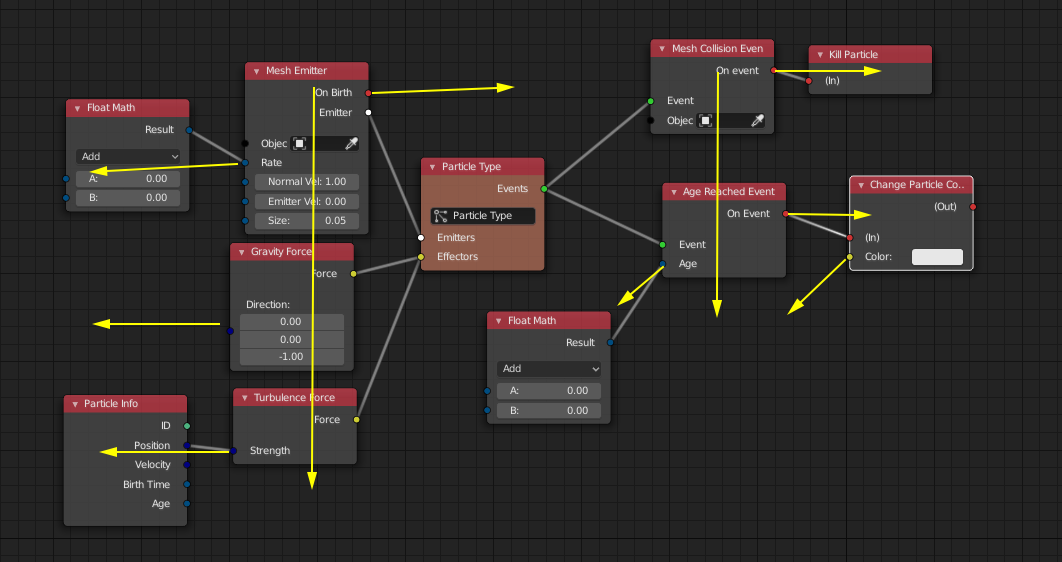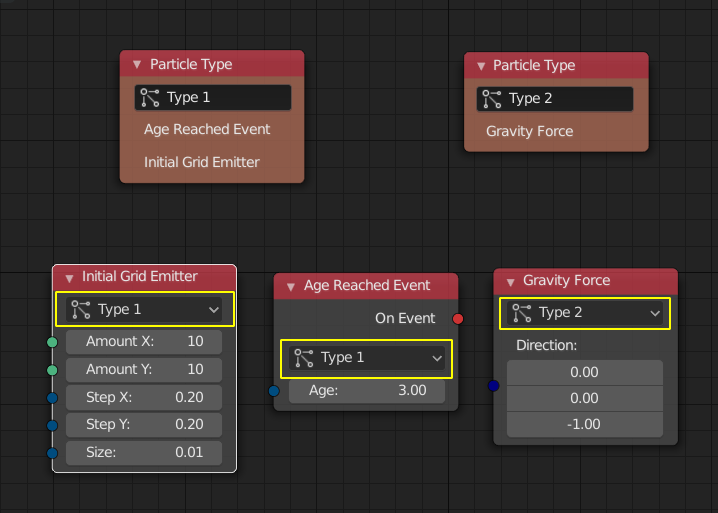Updated Particle Nodes UI¶
Some weeks ago I published a proposal on how a particle system can be represented with nodes (link). Now, after working on the system for a couple of weeks, I found a couple of weak points. This document explains the problems and presents an updated proposal.
Problems¶
There are two main problems, both of which I consider deal breakers.
Node Tree Growth¶
Users need to be able to extend node trees without getting in their own way all the time. The issue is that often other nodes are at the place where a new node is supposed to be. This has been partially solved with the Auto-Offset feature some years ago. With it, other nodes can automatically move out of the way when necessary.
In the original particle nodes ui proposal, this does not work well. This is because the node tree grows in too many directions at the same time. When the node tree becomes more complex, there is no room to expand.
Composition¶
One of the great features of nodes is that they can be packaged and reused. However, this was difficult with the original proposal. For example, when an Age Reached Event and a Gravity Force are put in a group for reuse, the group would have an "Events" input and a "Modifiers" output. It is not clear how that should be connected to the Particle Type node.
New Proposal¶
The main change I suggest is to get rid of all the links to the Particle Type node. Then it would not need the Emitters, Modifiers and Events sockets anymore. Semantically, they all were the same anyway. They just told the simulation system that these nodes belong together (unlike others, that transfer e.g. data). Fortunately, there are other ways to present this relationship to the user. One possible solution is to have an enum property in every relevant node that allows the user to select, which particle type it belongs to. Control flow through actions and data flow would still work exactly the same way.
This approach also simplifies solving the second problem. Every group can have an arbitrary number of Particle Type inputs. Instead of selecting a concrete particle type in the group, a "placeholders" can be selected. The particle types are then exposed as properties when the group is actually used.
Implications¶
This update has a couple of implications which are presented here.
Most prominently, the relation between particle types and the components (set of connected nodes) that control its behavior is less obvious now. Just having the name of the particle type in the node, might not be enough. However, there are more ways in which the relation can be hinted at the user. For example, whenever a Particle Type node is selected, the corresponding components are highlighted. Furthermore, users can organize the nodes such that everything related to one particle type is close together. Additionally, all the components, that a effect a particle type can be listed in the node itself.
It can be considered annoying to have to select the right particle type, every time a new component is added. Fortunately, this can be mostly automated. For example, a particle type node could have a button to that opens a search/menu. Nodes inserted from it will be setup already.
Previously, all nodes had to fit in one of the categories Emitter, Modifier and Event. This is fine for the basic building block nodes. However, when users group those together, the group does not fit into any of these categories anymore. In the new system, the categories don't exist anymore at the UI level, so it is no issue.
In the original proposal, nodes usually belong to one type. This was not really enforced, but connecting them to multiple particle type nodes would create a big mess. Now, a node can more easily use more than one particle type. For that it just has multiple particle type enum properties.
With that, the semantic of adding a new component also changes. Previously, adding a component meant adding new behavior to a particle type. Now, the semantic is more like adding behavior to the entire particle system (which in many cases just happens to affect a single particle type).
I'd argue that this new system is easier to learn, because there is less to learn. The distinction between emitters, modifiers and events does not have to be learned, because it does not exist. Also an entire class of links, links that represent just relations, is removed. So instead of having links with three different semantics, there are only two semantics left: data flow and control flow.
The concept of gates as presented in the original proposal does not work after this update. Alternatives can be found when necessary, but maybe this does not have to be a built-in feature. When custom attributes are supported, users should be able to build this themselves.
A limitation compared to the original proposal is, that a group cannot add new particle types to the system. So the number of particle types is exactly the number of Particle Type nodes in the node tree at the top of the hierarchy. I do not think that this is a bad limitation. In fact, most users would probably have a hard time conceptualizing more dynamic amounts of particle types. Having all particle types at the top level also makes creating identifiers for them easier. Furthermore, this will probably become beneficial when it comes to rendering and the user wants to control the shading of individual particle types.

